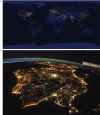The biological impacts of artificial light at night: the research challenge
- PMID: 25780244
- PMCID: PMC4375372
- DOI: 10.1098/rstb.2014.0133
The biological impacts of artificial light at night: the research challenge
Keywords: communities; dose-response; individuals; light spectrum; night-time.
Figures

References
-
- Hays GC. 2003. A review of the adaptive significance and ecosystem consequences of zooplankton diel vertical migrations. Hydrobiologia 503, 163–170. (10.1023/B:HYDR.0000008476.23617.b0) - DOI
-
- Kronfeld-Schor N, Dayan T. 2003. Partitioning of time as an ecological resource. Annu. Rev. Ecol. Evol. Syst. 34, 153–181. (10.1146/annurev.ecolsys.34.011802.132435) - DOI
Publication types
MeSH terms
LinkOut - more resources
Full Text Sources
Other Literature Sources
